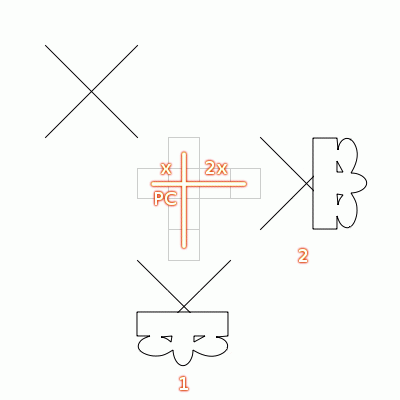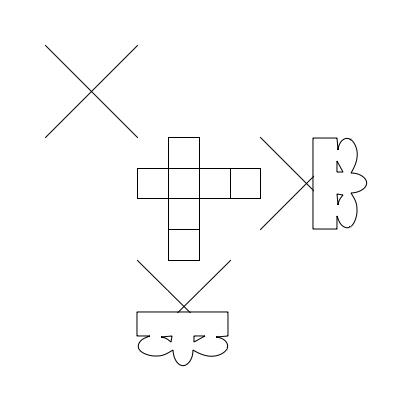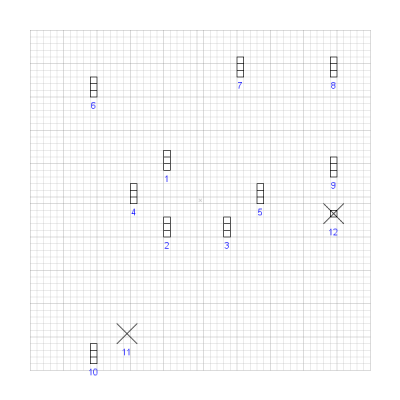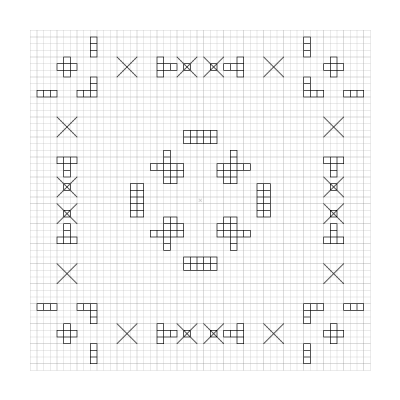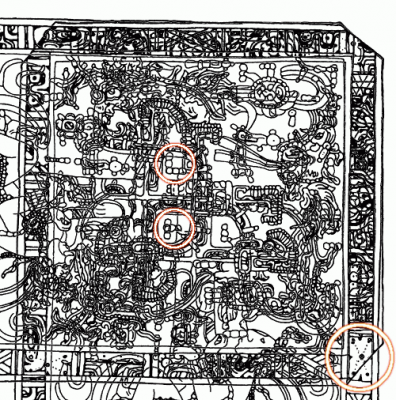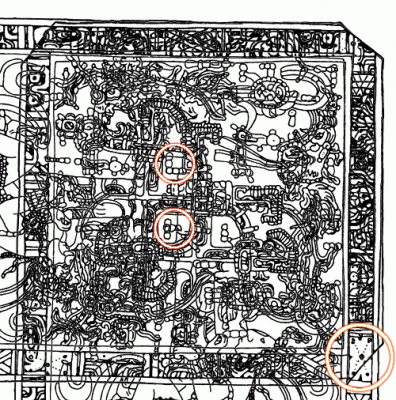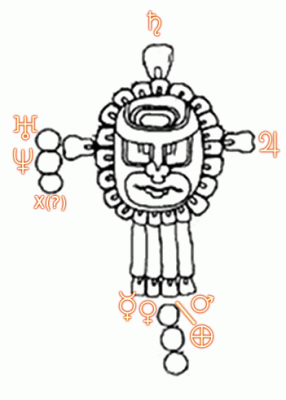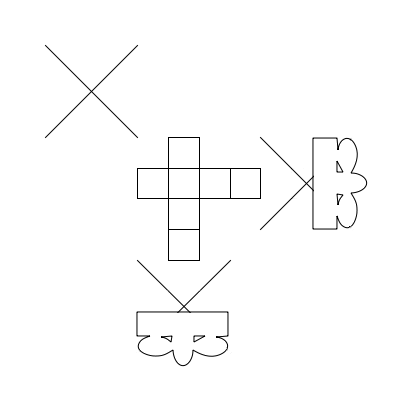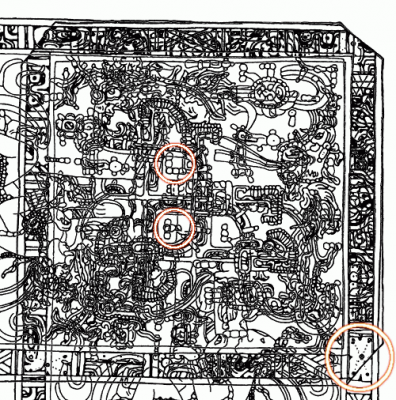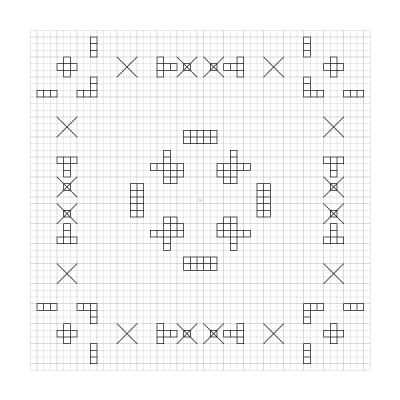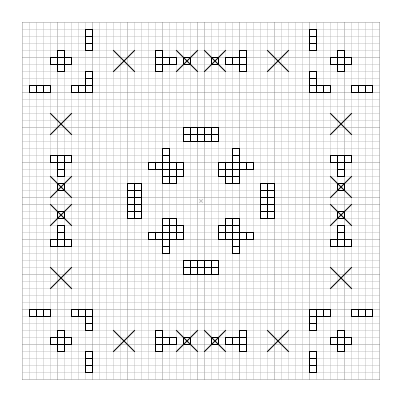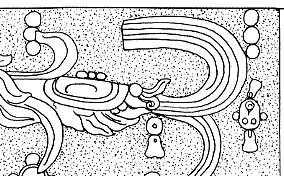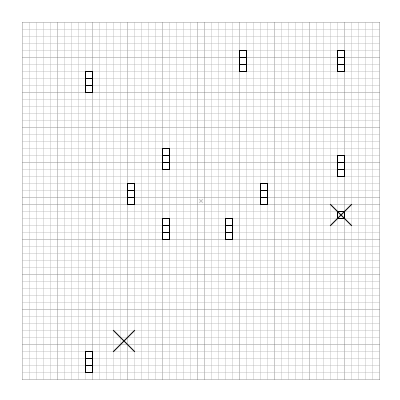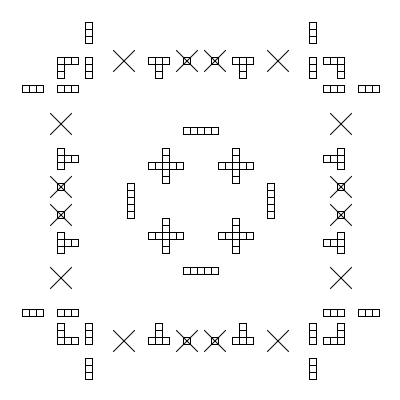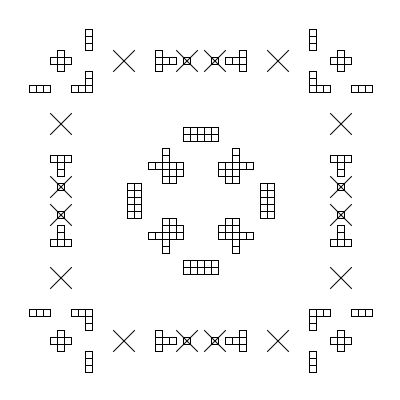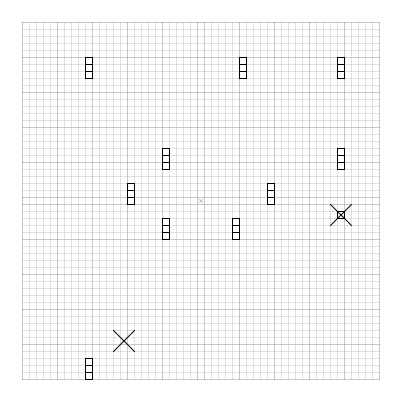-
Posts
20 -
Joined
-
Last visited
Content Type
Profiles
Forums
Events
Everything posted by Akusius
-
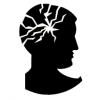
A hidden message encoded in the pattern of the Palenque lid?
Akusius replied to Akusius's topic in Speculations
We are talking about this diagram, depicting the two (or three) stars and squares between them: The two star symbols originally on the lid: This diagram could be a really sophisticated way to identify a binary solar system being three times as far away from us as the PC: Of course in itself it could be interpreted many ways, but together with the other diagram and considering the entire encoding procedure what other interpretation could be more probable? Such an argument can be used each time to debunk a potentially first evidence for an alien existence. But perhaps it would be a better approach to focus on the geometrical decoding at first and to ignore the final interpretation. OK, perhaps you are right. But is there a point in discussing this topic without even reviewing the operations? I admit it to be a fantastical (a "lunatic") hypothesis, but how to (dis)prove its potential validity without examining its steps? Maybe we should leave this topic until there is a motivation to discuss the decoding itself (and not only our prejudices favoring or against alien theories)... -

A hidden message encoded in the pattern of the Palenque lid?
Akusius replied to Akusius's topic in Speculations
Thanks! Unfortunately I had to realize, that this hypothesis obviously falls between two stools: it is too complicated for a popular ancient alien theory, and at the same time too fantastical for the scientific world. So nobody is really interested in it (although IMHO a very interesting topic and also a truly impressive encoding method)... But then what would be the scientifically correct way to prove this (or a similar) hypothesis? Now each step is documented thoroughly with the help of several animations and images. I also tried to justify carefully each operation, why was it the chosen one to be performed, etc. The only really missing part is an in-depth review of the process, but obviously I cannot do that myself. It's OK, if somebody is not interested in this (or similar) topic, but how on earth could it be presented in a (much) more scientific way? I would be really curious, what kind of demonstration would convince you (and other "official" scientists) about the seriousness of such a hypothesis? (aside from being published in the Nature...) -

A hidden message encoded in the pattern of the Palenque lid?
Akusius replied to Akusius's topic in Speculations
There was already a message revealed (you can find it at the end of the overview page, it apparently identifies another solar system). -

A hidden message encoded in the pattern of the Palenque lid?
Akusius replied to Akusius's topic in Speculations
I have already tried to compute probabilities for (very) basic scenarios, and also created computer-processable files for each state. The problem is that it's really hard to define mathematically, what makes a "well-arranged" pattern, and so intuition is still necessary to examine a layout... However, it seems already sure that the layout and the control state is special to a high degree (only the exact amount is uncertain). I'm really trying not to do so... I think, the most effective way to discuss the issue might be to focus at first exclusively on the geometrical part (i.e. to ignore temporarily the source of the pattern and its "lunatic" interpretation). So we have a 51x51-sized grid with 12 items in it (the exact coordinates of the items can be found here): And the question would be: how special is this layout, and what information could be contained within it? (Additionally, we also have a hint that we should rotate the pattern three times as a first decoding step.) -

A hidden message encoded in the pattern of the Palenque lid?
Akusius replied to Akusius's topic in Speculations
OK, no problem at all, thanks for looking through it! Of course, the rotations can be performed on any arbitrary item layout, but (most probably) we would not get a well-arranged pattern similar to the one in the control phase: IMHO it's almost impossible to get such an ordered pattern randomly and/or without anticipating it initially. So it seems obvious (at least to me) that there is indeed something special about the configuration of the triplets, and also there might be a code hidden in the pattern. But of course an in-depth review and a scientific discussion would be indispensable to verify this hypothesis... -

A hidden message encoded in the pattern of the Palenque lid?
Akusius replied to Akusius's topic in Speculations
Quick overview of the decoding: http://akusius.github.io/palenque/overview.html The solution process in detail: http://akusius.github.io/palenque/steps.html -

A hidden message encoded in the pattern of the Palenque lid?
Akusius replied to Akusius's topic in Speculations
Please focus on the highlight at the bottom right: There are the two X-shapes covering each other exactly (by "exactly" I mean: if we rotate the second layer around the center point of the upper square, then the two X shapes fall together precisely). What arbitrary choice have I made? It was not me who placed the X shapes there. I only recognized that they cover each other if we duplicate the pattern and rotate the second layer (which is BTW the direct consequence of the fact that the distance of the vertical X shape from the top is equal to the lid's width). Sorry, but you really seem to have already decided that this pattern could not contain a hidden code by any means, and so are obviously reluctant to even consider any possible argument against your presumption. (It's no problem at all, but then how to discuss it?) -

A hidden message encoded in the pattern of the Palenque lid?
Akusius replied to Akusius's topic in Speculations
Sorry, but no pareidolia here at all. Do the two X-shapes cover each other after the rotation? Yes. Do the triplets start to join inside? Yes, again. So it's absolutely not my fantasy, it is pure fact (and as I see, nobody could contradict it). The other solar system is identified as being a binary star approximately 3-times as far away from us as the PC, and having 3 inner and 3 outer planets. No direct identification yet, but this info should be enough to narrow down the search significantly. Please be aware that solving a puzzle or cracking a code requires (at least usually) multiple attempts and the testing of various methods and approaches. With "the only possible operation" phrase that singular operation was meant, which finally proved to be the only suitable action able to take the solution one step further. And my question would be again: how to interpret the fact that the two X-shapes cover each other exactly after the rotation? -

A hidden message encoded in the pattern of the Palenque lid?
Akusius replied to Akusius's topic in Speculations
I have spent quite a bit of time (almost 15 years by now) on this topic (of course not exclusively...) Also wrote several programs for the solution, e.g. a Java utility to test other layouts and operations. E.g. would be very grateful to learn what could be a good argument against bringing the two X-shapes to cover each other by rotation: Here is the animation for the operation. (And thanks for the responses...) -

A hidden message encoded in the pattern of the Palenque lid?
Akusius replied to Akusius's topic in Speculations
I myself would easily accept any good counterarguments (e.g. on a step-by-step basis). But the only real objection was until now, that the Mayans could not have produced such an encoded message (which to contradict is exactly the task, so it could be considered a logical fallacy to treat it as an undeniable truth from the beginning). Why not abstract from the source of this pattern instead? It could be handled, as if it were e.g. a modern-day puzzle presented in a magazine or similar. And then if it proves unsolvable or the suggested solution is wrong, it's OK, I would accept it without problem. But why to disapprove it immediately before any further examinations, just because "the Mayans surely could not have created such a code"? -

A hidden message encoded in the pattern of the Palenque lid?
Akusius replied to Akusius's topic in Speculations
Why arbitrary tricks? At each step we follow the hints of the puzzle and perform the only possible operation. The diagram contains the two (or three) stars and also squares between them. How else could you interpret it than a distance diagram? Also how else would you identify a solar system (if not by distance)? The identification of the Sun is encoded (and BTW distance-based). -

A hidden message encoded in the pattern of the Palenque lid?
Akusius replied to Akusius's topic in Speculations
Hiding the diagram behind a complex transformation process can make doubtless that it is indeed a message from a high-intelligence source. BTW, there is also an unhidden diagram on the lid (which could be interpreted as the diagram of the Solar System): But the distance diagram would have been to plain to include it directly (or rather the Solar System diagram too complex to hide it behind a transformation procedure). Apparently the designers wanted to demonstrate their intelligence level by using that complex process, and assure us, that this is indeed a secret message. I think, we should differentiate between the Mayans who carved the lid, and those who actually designed it (known maybe as the Gods of the Mayans?). The common Mayans had obviously no perception of the Solar System or other systems (at least not at the level needed for such a message). The (not human) designers were those who created the code, which is fully comprehensible without knowing any human language, only by using images and diagrams (similarly, as we constructed the Pioneer plaque to contact other civilizations). And then the common Mayans carved this design onto the lid, with many visible errors, and without having any clue about the meaning of it. -

A hidden message encoded in the pattern of the Palenque lid?
Akusius replied to Akusius's topic in Speculations
We can call it design, message or secret code, etc., it is not really relevant. The point is, that the pattern apparently has (or might have) a deeper level to interpret. (Similarly as e.g. a painter hides extra information into the painting through symbols.) This is not a textual message, but a diagram to illustrate the distance relation of the two (or actually three) stars: Textually it would be very hard to communicate such a message, because you have no words for solar systems, stars, distances, etc. (And the Mayan script is already image-based, so it could be reasonable to expect a hidden message in the configuration of the geometrical figures.) -

A hidden message encoded in the pattern of the Palenque lid?
Akusius replied to Akusius's topic in Speculations
IMHO there are too many coincidences in the pattern... E.g. there is the first hint: As you can see, if we rotate the second layer 90° clockwise, the two X-shapes cover each other exactly, and also the triplets inside start to connect. How probable would be that without a prior design? (and this is only the first step...) -

A hidden message encoded in the pattern of the Palenque lid?
Akusius replied to Akusius's topic in Speculations
I think the dotted X-shape is different from the script X. We can see both of them on the lid (interestingly both times next to each other): AFAIK, the dotted X is not part of the Mayan script. I have already tried to contact Dr. David Stuart to reassure this, but got no response yet. You're absolutely right, Cotterell did similar decodings. Actually one of his books was the main motivation that I personally started to study the Palenque lid (as it is disclosed on the story page). I think, his decoding is much more fantastical than mine, because he uses the entire image without normalizing it into a coordinate system, etc. In my solution only the triplets and the two star symbols are used, and they are placed into a coordinate system, which enables us to handle them mathematically, etc. So IMHO, this deciphering is scientifically much more justifiable. But of course a serious peer-review would be really necessary to verify it. (Unfortunately I cannot find anybody to invest some time into the peer-review...) OK, but the operations performed here are IMHO far from being arbitrary. We barely follow the hints of the pattern step by step (the reflection step perhaps could be considered as somewhat subjective, but the others can be fully reasoned). E.g. to bring the two dotted X shapes to cover each other, there is only one suitable operation: to duplicate the pattern and rotate the second layer. And then we must perform another two rotations to cover each X, and so on, step by step, until the shape inside is complete. --------------------------- Meanwhile, managed to apply a 3x3-sized grid to the pattern: As we can see, the outer edge is perfect: each element is inside a 3x3 square, and also each gap has this size. It would be great to compute somehow, how probable it is to get such a well-ordered pattern after the rotations (presumably not too much)... -

A hidden message encoded in the pattern of the Palenque lid?
Akusius replied to Akusius's topic in Speculations
Symmetrical was perhaps not the right word... What I wanted to say: the pattern is surprisingly ordered and well-arranged after the rotations (which I think is not at all self-evident). We can see e.g., that on the outer edge each item is placed on a square, and each of them (and also each gap!) has a 3x3-size: As I see, it is very hard to construct (even intentionally) a layout, which results in such a well-arranged end state (after the three rotations and the reflection). The fourth image above shows the same design with only minimal modifications: as you can see, after the rotations the outer edge is almost completely broken. As far as I know, the three-circled items are interpreted by the experts as simple decorations or gap fillers (without any symbolic meaning). So they seem to have no real explanations for these elements and their positions... -

A hidden message encoded in the pattern of the Palenque lid?
Akusius replied to Akusius's topic in Speculations
OK, but for art history all these items (triplets, star symbols, etc.) are simply "ornaments". But it brings up the question, why then aren't they equally distributed over the entire lid? (all triplets and star symbols are located in the upper half) And also, why were these supposed "ornaments" placed before and behind the other figures? As it is visible e.g. here: -

A hidden message encoded in the pattern of the Palenque lid?
Akusius replied to Akusius's topic in Speculations
Yes, I'm aware that the figure in the Temple of the Cross includes some similar shapes ... (maybe borrowed from the lid?) The initial layout does already involve a degree of symmetry, but (as I see) it is not really striking on itself: However, after performing the three rotations and the reflection the obtained pattern is surprisingly symmetrical: So it seems (at least to me), as if the designers already had this image in mind when placing the items. Interestingly, if we move some items away, we can create an even more symmetrical initial layout: But if we perform the same operations on it, the result is apparently less ordered: As we can see, the outer edge is almost completely ruined. The inner part is maybe a bit more symmetrical in this case, but we could not execute the next step on this shape (moving the items toward the center). So I think it is not only the initial symmetry multiplied by the rotations playing a part here, because it would not be sufficient on itself to produce the pattern. The best would be to have some kind of geometrical framework for such encoding methods, and so one could analyze the pattern and compute the probabilities exactly with the help of it (unfortunately I haven't found anything suitable yet...) (Also don't really see, actually which academic discipline would be responsible for such a unique encoding method, and so where to search for the required theories and algorithms...) -
This is the lid in question: http://mesoweb.com/Palenque/monuments/TI_sarcophagus/099.html The position and configuration of the three-circled items ("triplets") and the two star symbols on the upper part of the lid seems remarkably special (which also contradicts the hypothesis about them serving only decoration purposes). Isn't it possible that they actually form together a system to encode a hidden message? More information on a separate page (as it requires several animations and images to decipher the code): http://akusius.github.io/palenque/overview.html Although I was not able yet to compute the exact probability for this interpretation, but it seems really unlikely that randomly placed items could produce such an ordered appearance. Any ideas on this? Thanks!
-
Hello! Just would like to share an idea about measuring variables in the social sciences (especially in psychology) more efficiently. E.g. let's try to measure the extroversion trait in a group (or in the population). Today our method is to construct a survey, which tries to measure the various aspects of this characteristic numerically (e.g. with the help of 1-5 scales). Then we apply a numerical model to the results, and get a final value for the extroversion quality of each individual. The problem with this approach is, that the end result is too closely attached to the actual survey and numerical model, and it cannot be generalized easily. Furthermore it is already questionable, whether the usage of numbers for psychological qualities can be justified at all, since it seems not to have much sense of speaking about e.g. twice as large extroversion, etc. So we should obviously find another measuring method, which does ensure accuracy but without the necessity of using numbers or numerical models for this purpose. Would not a sorting algorithm based on multiple direct comparisons be a more effective way of measuring these variables (similarly to that used e.g. in the object-oriented programming languages for sorting the objects according to a certain aspect)? E.g. for measuring the extroversion quality only one single comparison function would be needed, which would provide a <, = or > result (consistently) for comparing two individuals based on their extroversion. Performing this comparison multiple times we would get a perfectly defined scale at the end, and so we could measure this trait accurately without the use of any numbers. Further advantages of this method could be (described in a more elaborated manner on this page): - the comparison function is much simpler and more elementary, than the number scales used in the questionnaires; - the brain is much more consistent in providing such types of comparisons, than assigning numbers in a scale; - the "brutality" of the comparison function enforces the formation of conscious judgments; - the comparison function itself is already verified technically by the sorting algorithm; - this measuring method could facilitate considerably the exchange of the scientific results between various groups and laboratories (because the comparison functions on their own could already be exchanged without any theories); - with the help of well-functioning comparison methods reference lists could be constructed, which then could be used to measure other items; - a well-behaving comparison method could also be used in reverse mode, i.e. to define new qualities and variables. Would this idea make any sense, or there were perhaps already attempts in that direction previously? Thank you!




